Multitemporal Spatial Analysis of Land Use and Land Cover Changes in the Lower Jaguaribe Hydrographic Sub-Basin, Ceará, Northeast Brazil
Abstract
:1. Introduction
2. Materials and Methods
2.1. Study Area
2.2. Processing of Satellite Images
2.2.1. Data Acquisition
2.2.2. Image Processing
2.2.3. Validation
3. Results and Discussion
3.1. Spatiotemporal Analysis of Land Use
3.2. Water Surface Change
4. Conclusions
Author Contributions
Funding
Data Availability Statement
Acknowledgments
Conflicts of Interest
References
- López-Carr, D. A Review of Small Farmer Land Use and Deforestation in Tropical Forest Frontiers: Implications for Conservation and Sustainable Livelihoods. Land 2021, 10, 1113. [Google Scholar] [CrossRef]
- Gu, X.; Long, A.; Liu, G.; Yu, J.; Wang, H.; Yang, Y.; Zhang, P. Changes in Ecosystem Service Value in the 1 km Lakeshore Zone of Poyang Lake from 1980 to 2020. Land 2021, 10, 951. [Google Scholar] [CrossRef]
- Huajun, T.; Wenbin, W.; Peng, Y.; Youqi, C.; Verburg, P.H. Recent progresses of land use and land cover change (lucc) models. Acta Geogr. Sin. 2009, 64, 456–468. [Google Scholar] [CrossRef]
- Alexander, P.; Rounsevell, M.D.A.; Dislich, C.; Dodson, J.R.; Engström, K.; Moran, D. Drivers for global agricultural land use change: The nexus of diet, population, yield and bioenergy. Glob. Environ. Chang. 2015, 35, 138–147. [Google Scholar] [CrossRef] [Green Version]
- Acheampong, E.O.; Macgregor, C.J.; Sloan, S.; Sayer, J. Deforestation is driven by agricultural expansion in Ghana’s forest reserves. Sci. Afr. 2019, 5, e00146. [Google Scholar] [CrossRef]
- Machiwa, H.; Mango, J.; Sengupta, D.; Zhou, Y. Using Time-Series Remote Sensing Images in Monitoring the Spatial–Temporal Dynamics of LULC in the Msimbazi Basin, Tanzania. Land 2021, 10, 1139. [Google Scholar] [CrossRef]
- Regasa, M.S.; Nones, M.; Adeba, D. A Review on Land Use and Land Cover Change in Ethiopian Basins. Land 2021, 10, 585. [Google Scholar] [CrossRef]
- Alves, W.S.; Martins, A.P.; Pôssa, E.M.; Moura, D.M.B.; Morais, W.A.; Ferreira, R.S.; Santos, L.N.S. Geotechnologies applied in the analysis of land use and land cover (LULC) transition in a hydrographic basin in the Brazilian Cerrado. Remote Sens. Appl. Soc. Environ. 2021, 22, 100495. [Google Scholar] [CrossRef]
- SEMACE. Relatório final de caracterização ambiental e dos mapeamentos. In Reestruturação e Atualização do Mapeamento do Projeto Zoneamento Ecológico-Econômico do Ceará—Zona Costeira e Unidades de Conservação Costeiras; SEMACE: Fortaleza, Brazil, 2016; p. 480. [Google Scholar]
- Ribeiro, L.F.; de Souza, M.C.M.B.N.; Barros, F.; Hatje, V. Challenges of Shrimp Farming: Legal Aspects, Environmental Impacts and Mitigating Alternatives. J. Integr. Coast. Zone Manag. 2014, 14, 365–383. [Google Scholar] [CrossRef] [Green Version]
- Mota, L.H.D.S.D.O.; Valladares, G.S.; Leite, H.M.F.; Gomes, A.D.S.; Magalhães, R.M.F.; Silva, T.A.D. Análise Multitemporal Do Uso e Cobertura Das Terras Da Região Do Baixo Acaraú-CE. Geociências 2013, 32, 379–396. [Google Scholar]
- De Sousa Barbosa, W.C.; Valladares, G.S. Analysis of the Landscape and Land Use Changes in the Brazilian Northeast, Semiarid Coast. Soc. Nat. 2020, 32, 674–686. [Google Scholar] [CrossRef]
- Shrestha, M.; Shrestha, S.; Shrestha, P.K. Evaluation of Land Use Change and Its Impact on Water Yield in Songkhram River Basin, Thailand. Int. J. River Basin Manag. 2020, 18, 23–31. [Google Scholar] [CrossRef]
- Lal, A.M.; Anouncia, M.S. Semi-supervised change detection approach combining sparse fusion and constrained k means for multi-temporal remote sensing images. Egypt. J. Remote Sens. Space Sci. 2015, 18, 279–288. [Google Scholar] [CrossRef] [Green Version]
- Jensen, J.R. Sensoriamento Remoto Do Ambiente: Uma Perspectiva Em Recursos Terrestres; Prentice Hall: Hoboken, NJ, USA, 2009; ISBN 978-85-60507-06-1. [Google Scholar]
- Jensen, J.R. Introductory Digital Image Processing: A Remote Sensing Perspective, 4th ed.; Prentice Hall: Hoboken, NJ, USA, 2015; ISBN 9780134058160. [Google Scholar]
- Tesfaye, B.; Lengoiboni, M.; Zevenbergen, J.; Simane, B. Mapping Land Use Land Cover Changes and their determinants in the context of a massive free labour mobilization campaign: Evidence from South Wollo, Ethiopia. Remote Sens. 2021, 13, 5078. [Google Scholar] [CrossRef]
- Yang, N.; Mo, W.; Li, M.; Zhang, X.; Chen, M.; Li, F.; Gao, W. A study on the spatio-temporal land use changes and ecological response of the Dongting Lake Catchment. ISPRS Int. J. Geo Inf. 2021, 10, 716. [Google Scholar] [CrossRef]
- Ye, J.; Hu, Y.; Zhen, L.; Wang, H.; Zhang, Y. Analysis on Land-Use Change and its driving mechanism in Xilingol, China, during 2000–2020 using the google earth engine. Remote Sens. 2021, 13, 5134. [Google Scholar] [CrossRef]
- IBGE. Manuais Técnicos Em Geociências, No 7: Manual Técnico de Uso Da Terra, 3rd ed.; IBGE: Rio de Janeiro, Brazil, 2013; ISBN 9788524043079.
- ANA. Manual de Procedimentos Técnicos e Administrativos de Outorga de Direito de Uso de Recursos Hídricos Da Agência Nacional de Águas; ANA: Brasilia, Brazil, 2014; Volume 2013.
- RADAMBRASIL. Folhas SB. 24/25 Jaguaribe/Natal: Geologia, Geomorfologia, Pedologia, Vegetação e Uso e Potencial Do Solo. 1981. Available online: https://biblioteca.ibge.gov.br/biblioteca-catalogo.html?id=216333&view=detalhes (accessed on 4 October 2018).
- INESP. Caderno Regional Da Sub-Bacia Do Baixo Jaguaribe; INESP: Fortaleza, Brazil, 2009. [Google Scholar]
- FUNCEME. Calendário Das Chuvas No Estado Do Ceará; FUNCEME: Fortaleza, Brazil, 2021. [Google Scholar]
- Xavier, L.C.P.; Carvalho, T.M.N.; Filho, J.D.P.; de Souza Filho, F.A.; da Silva, S.M.O. Use of Machine Learning in Evaluation of Drought Perception in Irrigated Agriculture: The Case of an Irrigated Perimeter in Brazil. Water 2020, 12, 1546. [Google Scholar] [CrossRef]
- Agência de Desenvolvimento do Estado do Ceará (ADECE). Perímetros Público Irrigados Do Ceará; Agência de Desenvolvimento do Estado do Ceará (ADECE): Fortaleza, Brazil, 2011; p. 20.
- IBAMA Diagnóstico Da Carcinicultura No Estado Do Ceará; IBAMA: Brasilia, Brazil, 2005.
- ABCC/MAPA. Censo Da Carcinicultura Do Litoral Sul Do Estado Do Ceará e Zonas Interioranas Adjacentes 2015/2016, 1st ed.; ABCC/MAPA: Natal, Brazil, 2017. [Google Scholar]
- Diniz, C.; Cortinhas, L.; Pinheiro, M.L.; Sadeck, L.; Filho, A.F.; Baumann, L.R.F.; Adami, M.; Souza-Filho, P.W.M. A Large-Scale Deep-Learning Approach for Multi-Temporal Aqua and Salt-Culture Mapping. Remote Sens. 2021, 13, 1415. [Google Scholar] [CrossRef]
- USGS Landsat Archives. Available online: https://www.usgs.gov/core-science-systems/nli/landsat (accessed on 4 October 2018).
- Pekel, J.-F.; Cottam, A.; Gorelick, N.; Belward, A.S. High-Resolution Mapping of Global Surface Water and Its Long-Term Changes. Nature 2016, 540, 418–422. [Google Scholar] [CrossRef]
- Dorber, M.; Verones, F.; Nakaoka, M.; Sudo, K. Can We Locate Shrimp Aquaculture Areas from Space?—A Case Study for Thailand. Remote Sens. Appl. Soc. Environ. 2020, 20, 100416. [Google Scholar] [CrossRef]
- Rouse, J.W.; Haas, R.H.; Scheel, J.A.; Deering, D.W. Monitoring Vegetation Systems in the Great Plains with ERTS. In Proceedings of the 3rd Earth Resource Technology Satellite (ERTS) Symposium, Washington, DC, USA, 10–14 December 1973; Scientific and Technical Information Office, National Aeronautics and Space Administration: Washington, DC, USA, 1974; pp. 309–317. [Google Scholar]
- Winkler, K.; Fuchs, R.; Rounsevell, M.; Herold, M. Global Land Use Changes Are Four Times Greater than Previously Estimated. Nat. Commun. 2021, 12, 2501. [Google Scholar] [CrossRef]
- Prasad, K.A.; Ottinger, M.; Wei, C.; Leinenkugel, P. Assessment of Coastal Aquaculture for India from Sentinel-1 SAR Time Series. Remote Sens. 2019, 11, 357. [Google Scholar] [CrossRef] [Green Version]
- Sun, Z.; Luo, J.; Yang, J.; Yu, Q.; Zhang, L.; Xue, K.; Lu, L. Nation-Scale Mapping of Coastal Aquaculture Ponds with Sentinel-1 SAR Data Using Google Earth Engine. Remote Sens. 2020, 12, 3086. [Google Scholar] [CrossRef]
- Congalton, R.G.; Green, K. Assessing the Accuracy of Remotely Sensed Data Principles and Practices, 3rd ed.; CRC Press: Boca Raton, FL, USA, 2020; Volume 53, ISBN 9788578110796. [Google Scholar]
- Diep, N.T.H.; Korsem, T.; Can, N.T.; Phonphan, W.; Minh, V.Q. Determination of Aquaculture Distribution by Using Remote Sensing Technology in Thanh Phu District, Ben Tre Province, Vietnam. Vietnam J. Sci. Technol. Eng. 2019, 61, 35–41. [Google Scholar] [CrossRef] [Green Version]
- Barbosa, H.A.; Huete, A.R.; Baethgen, W.E. A 20-Year Study of NDVI Variability over the Northeast Region of Brazil. J. Arid Environ. 2006, 67, 288–307. [Google Scholar] [CrossRef]
- FAO. The State of World Fisheries and Aquaculture 2020. Sustainability in Action; FAO: Rome, Italy, 2020. [Google Scholar]
- Souza, C.M.; Shimbo, J.Z.; Rosa, M.R.; Parente, L.L.; Alencar, A.A.; Rudorff, B.F.T.; Hasenack, H.; Matsumoto, M.; Ferreira, L.G.; Souza-Filho, P.W.M.; et al. Reconstructing Three Decades of Land Use and Land Cover Changes in Brazilian Biomes with Landsat Archive and Earth Engine. Remote Sens. 2020, 12, 2735. [Google Scholar] [CrossRef]
- Abdullah, A.Y.M.; Masrur, A.; Gani Adnan, M.S.; al Baky, M.A.; Hassan, Q.K.; Dewan, A. Spatio-Temporal Patterns of Land Use/Land Cover Change in the Heterogeneous Coastal Region of Bangladesh between 1990 and 2017. Remote Sens. 2019, 11, 790. [Google Scholar] [CrossRef] [Green Version]
- Dhar, A.R.; Uddin, M.T.; Roy, M.K. Assessment of Organic Shrimp Farming Sustainability from Economic and Environmental Viewpoints in Bangladesh. Environ. Res. 2020, 180, 108879. [Google Scholar] [CrossRef]
- Diniz, C.; Cortinhas, L.; Nerino, G.; Rodrigues, J.; Sadeck, L.; Adami, M.; Souza-Filho, P. Brazilian Mangrove Status: Three Decades of Satellite Data Analysis. Remote Sens. 2019, 11, 808. [Google Scholar] [CrossRef] [Green Version]
- Stiller, D.; Ottinger, M.; Leinenkugel, P. Spatio-Temporal Patterns of Coastal Aquaculture Derived from Sentinel-1 Time Series Data and the Full Landsat Archive. Remote Sens. 2019, 11, 1707. [Google Scholar] [CrossRef] [Green Version]
- Rodrigues, F.G.d.S.; Kelting, F.M.S. Landscape and Marine Shrimp Culture in Estuary River Jaguaribe, Aracati, Ceará. Geonordeste 2010, 1, 51–65. [Google Scholar]
- Rahman, M.R.; Ando, K.; Takeda, S. Development of Shrimp-Based Cropping Systems in the Coastal Area of Bangladesh: A Village-Level Study in Satkhira District. J. Land Use Sci. 2014, 9, 195–210. [Google Scholar] [CrossRef]
- Barai, K.R.; Harashina, K.; Satta, N.; Annaka, T. Comparative Analysis of Land-Use Pattern and Socioeconomic Status between Shrimp- and Rice- Production Areas in Southwestern Coastal Bangladesh: A Land-Use/Cover Change Analysis over 30 Years. J. Coast. Conserv. 2019, 23, 531–542. [Google Scholar] [CrossRef]
- Sá, T.D.; de Sousa, R.R.; Rocha, Í.R.C.B.; de Lima, G.C.; Costa, F.H.F. Brackish Shrimp Farming in Northeastern Brazil: The Environmental and Socio-Economic Impacts and Sustainability. Nat. Resour. 2013, 04, 538–550. [Google Scholar] [CrossRef] [Green Version]
- Ahmed, S. Shrimp Farming at the Interface of Land Use Change and Marginalization of Local Farmers: Critical Insights from Southwest Coastal Bangladesh. J. Land Use Sci. 2018, 13, 251–258. [Google Scholar] [CrossRef]
- Long, J.; Napton, D.; Giri, C.; Graesser, J. A Mapping and Monitoring Assessment of the Philippines’ Mangrove Forests from 1990 to 2010. J. Coast. Res. 2014, 30, 260–271. [Google Scholar] [CrossRef]
- Nguyen, H.H. The Relation of Coastal Mangrove Changes and Adjacent Land-Use: A Review in Southeast Asia and Kien Giang, Vietnam. Ocean Coast. Manag. 2014, 90, 1–10. [Google Scholar] [CrossRef]
- Díaz, I.; Mello, A.L.; Salhi, M.; Spinetti, M.; Bessonart, M.; Achkar, M. Multiscalar Land Suitability Assessment for Aquaculture Production in Uruguay. Aquac. Res. 2017, 48, 3052–3065. [Google Scholar] [CrossRef]
- Sivaraman, I.; Krishnan, M.; Radhakrishnan, K. Better Management Practices for Sustainable Small-Scale Shrimp Farming. J. Clean. Prod. 2019, 214, 559–572. [Google Scholar] [CrossRef]
- Jayasinghe, J.M.P.K.; Gamage, D.G.N.D.; Jayasinghe, J.M.H.A. Combating climate change impacts for shrimp aquaculture through adaptations: Sri lankan perspective. In Sustainable Solutions for Food Security: Combating Climate Change by Adaptation; Springer International Publishing: New York, NY, USA, 2019; pp. 287–309. ISBN 9783319778785. [Google Scholar]
- Bojórquez-Tapia, L.A.; Días-Mondragón, S.; Ezcurra, E. GIS-Based Approach for Participatory Decision Making and Land Suitability Assessment. Int. J. Geogr. Inf. Sci. 2001, 15, 129–151. [Google Scholar] [CrossRef]
- Rêgo, L.C.; da Silva Costa, J.P.; de Castro Cardoso Cardoso, G.C.; dos Santos, C.V. A Graph Model Analysis of the Conflict in the Irrigated Perimeter in Chapada Do Apodi-Brazil. Environ. Chall. 2021, 4, 100124. [Google Scholar] [CrossRef]
- Freitas, B.M.C.; Bombardi, L.M. A Política Nacional de Irrigação e o Uso de Agrotóxicos No Brasil: Contaminação e Intoxicações No Ceará. GEOgraphia 2018, 20, 86. [Google Scholar] [CrossRef]
- Da Silva, J.M.C.; Lacher, T.E. Caatinga—South America; Elsevier Inc.: Amsterdam, The Netherlands, 2020; ISBN 9780124095489. [Google Scholar]
- Bezerra, F.G.S.; Aguiar, A.P.D.; Alvalá, R.C.S.; Giarolla, A.; Bezerra, K.R.A.; Lima, P.V.P.S.; do Nascimento, F.R.; Arai, E. Analysis of Areas Undergoing Desertification, Using EVI2 Multi-Temporal Data Based on MODIS Imagery as Indicator. Ecol. Indic. 2020, 117, 106579. [Google Scholar] [CrossRef]
- Salazar, A.A.; Arellano, E.C.; Muñoz-sáez, A.; Miranda, M.D.; da Silva, F.O.; Zielonka, N.B.; Crowther, L.P.; Silva-ferreira, V.; Oliveira-reboucas, P.; Dicks, L.V. Restoration and Conservation of Priority Areas of Caatinga’s Semi-arid Forest Remnants Can Support Connectivity within an Agricultural Landscape. Land 2021, 10, 550. [Google Scholar] [CrossRef]
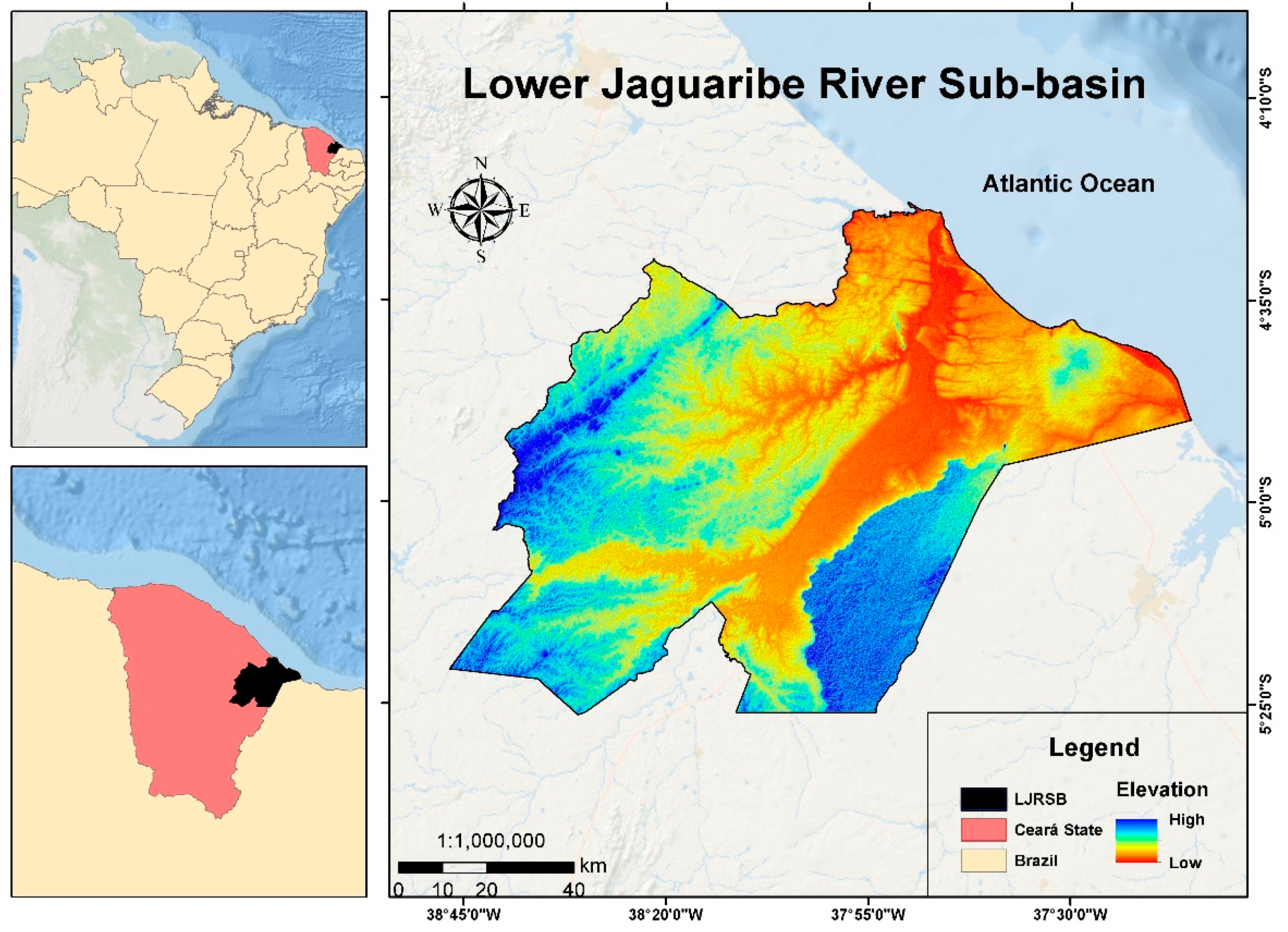
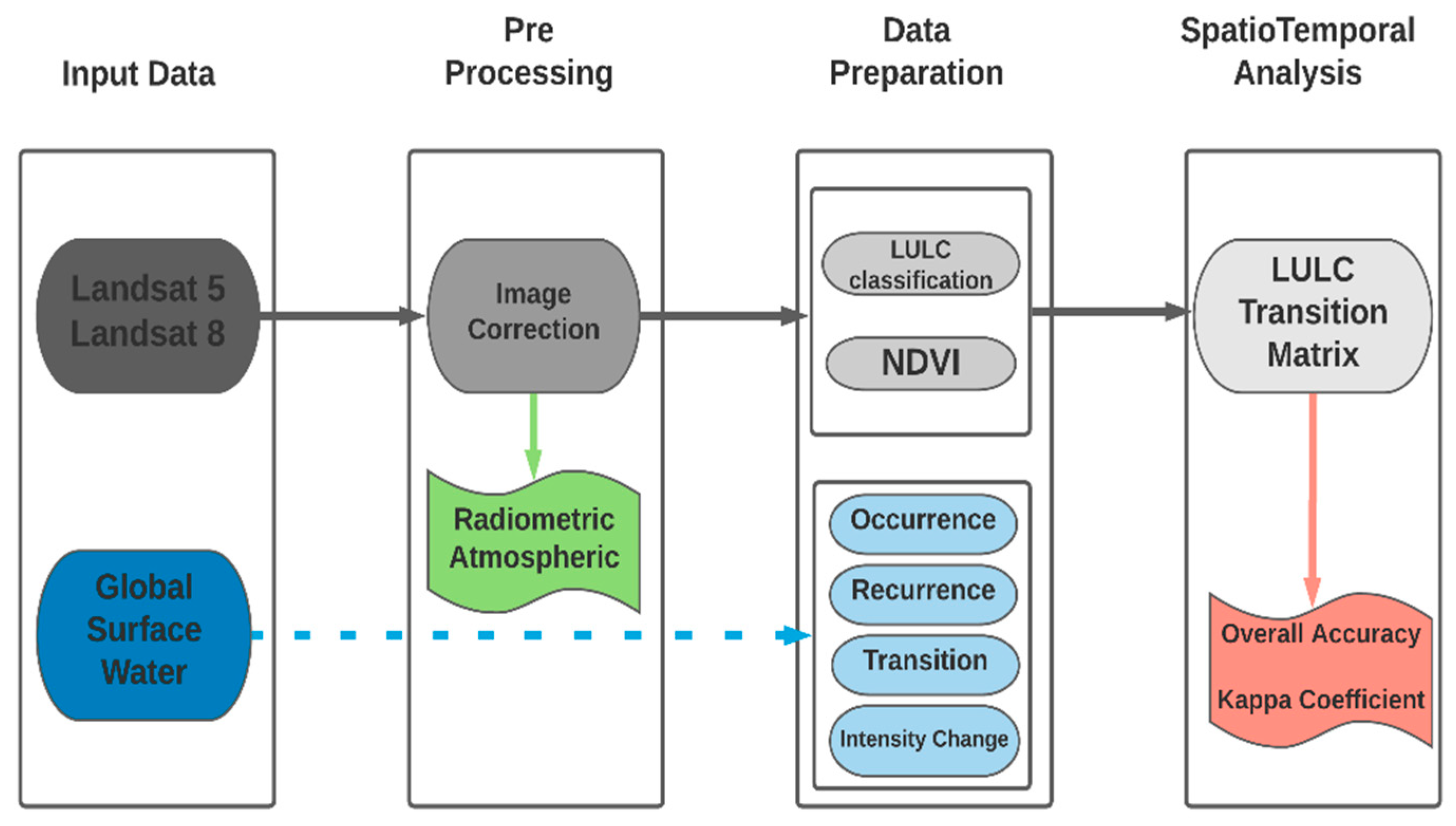


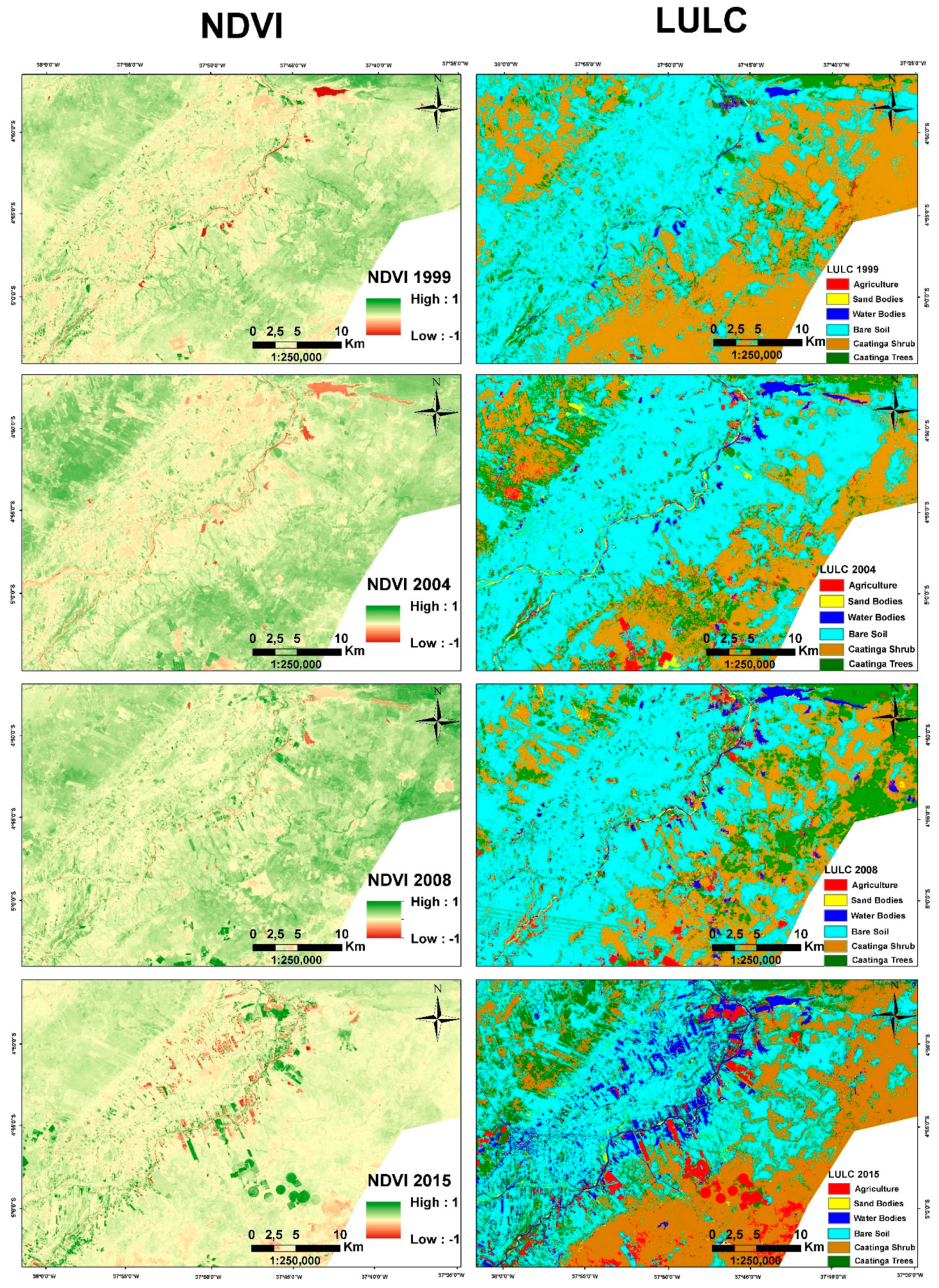
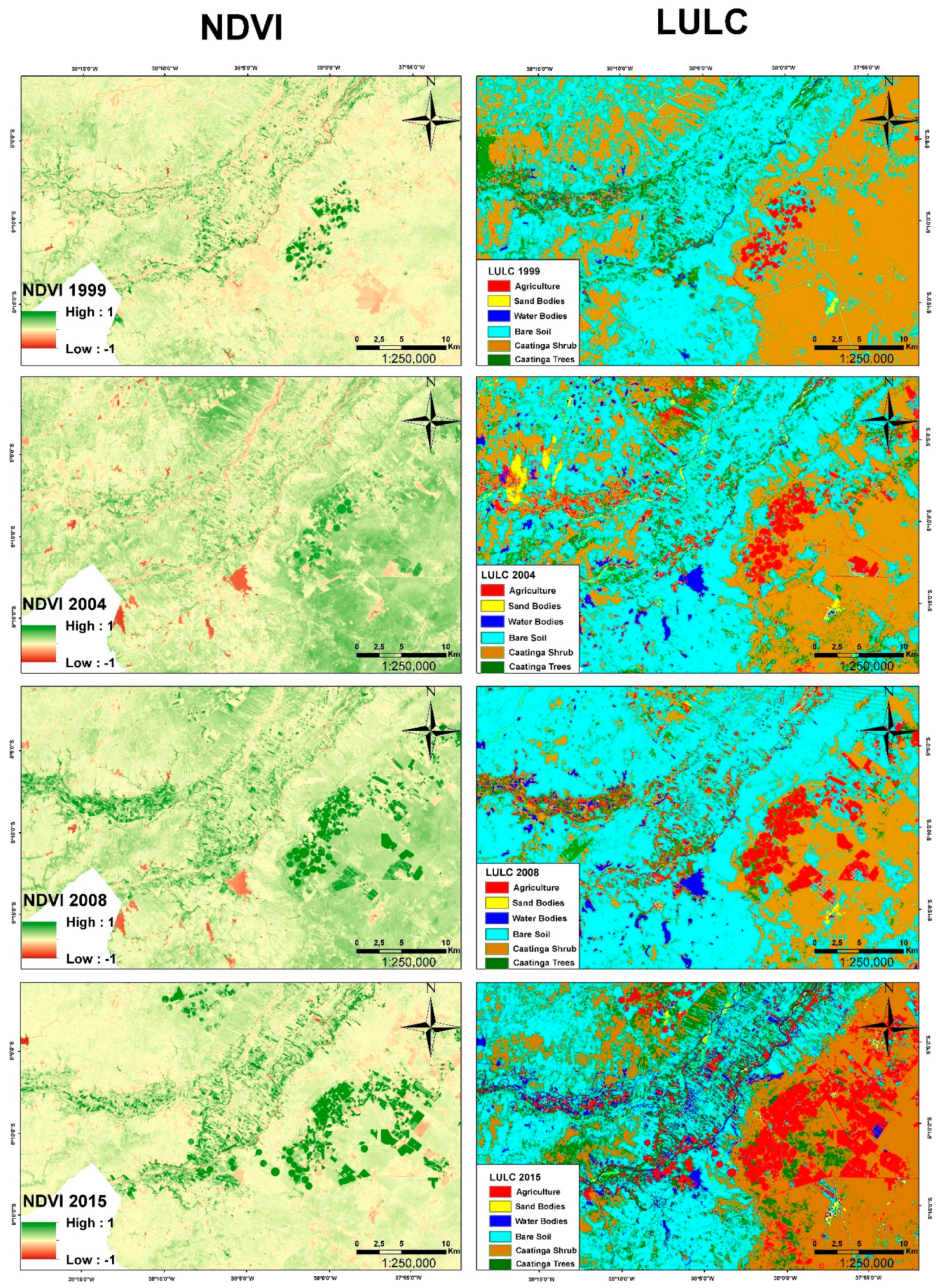
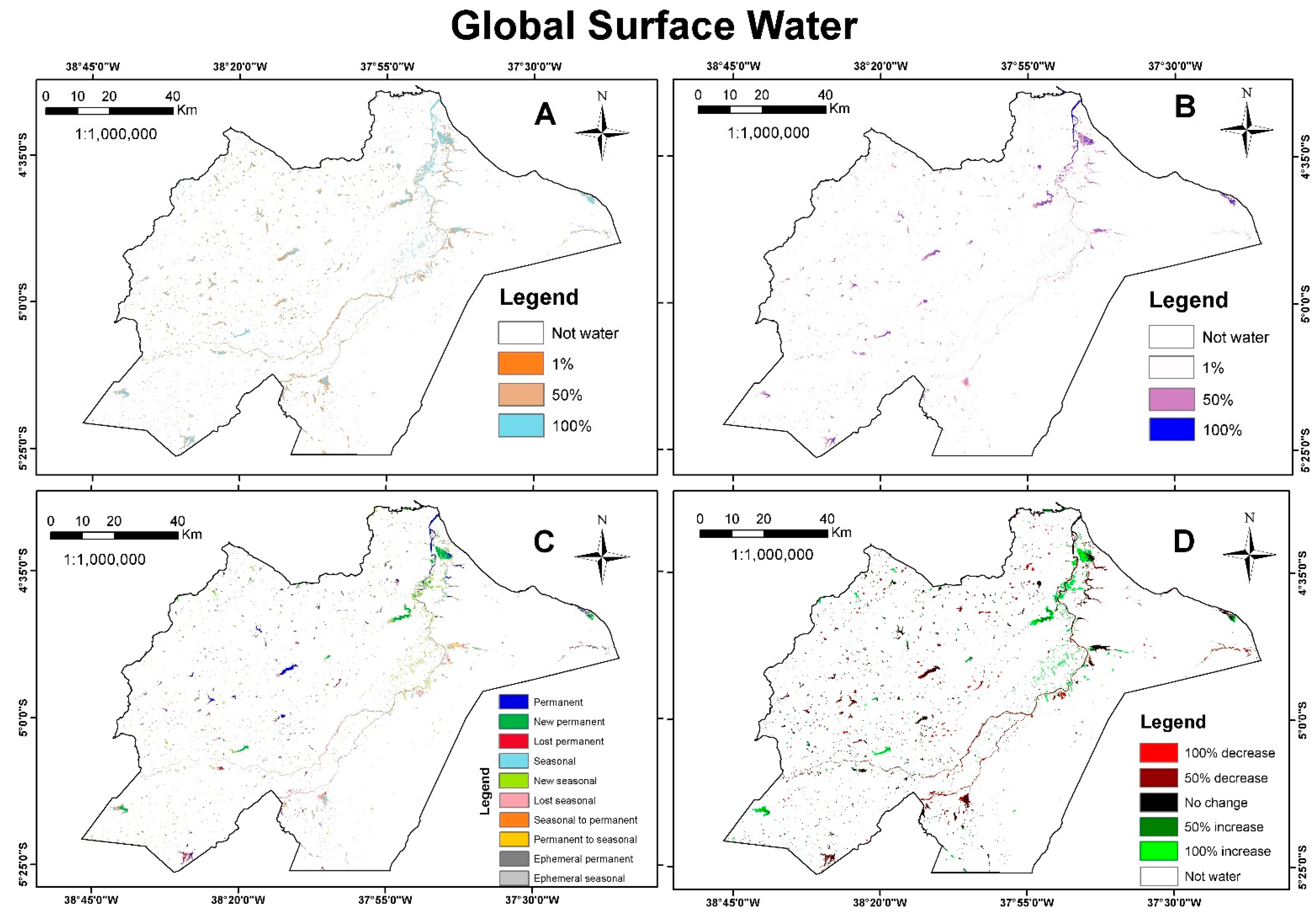


| Month/Year | Mean (mm) | Observed (mm) | Deviation (%) |
|---|---|---|---|
| 09/1999 | 1.1 | 0.4 | −63.2 |
| 08/2004 | 5.0 | 0.9 | −82.7 |
| 09/2008 | 1.1 | 0.7 | −38.7 |
| 09/2015 | 1.1 | 0.0 | −100.0 |
| City | 2005 | 2017 |
|---|---|---|
| Aracati | 77 | 148 |
| Jaguaruana | 27 | 202 |
| Fortim | 24 | 101 |
| Itaiçaba | 15 | 17 |
| Icapuí | 07 | 07 |
| Russas | 02 | 03 |
| Limoeiro do Norte | 02 | 06 |
| TOTAL | 157 |
| Year | Date | Scene |
|---|---|---|
| 1999 | 22 September | 216/63 and 216/64 |
| 2004 | 02 August | 216/63 and 216/64 |
| 2008 | 14 September | 216/63 and 216/64 |
| 2015 | 04 September | 216/63 and 216/64 |
| 1999 | 2004 | 2008 | 2015 | |
|---|---|---|---|---|
| Water bodies | 1.0% | 2.6% | 2.4% | 2.8% |
| Sandy bodies | 1.3% | 1.3% | 0.8% | 1.3% |
| Bare soil | 25.8% | 27.5% | 52.3% | 31.2% |
| Caatinga trees | 15.8% | 19.3% | 19.2% | 17.7% |
| Caatinga shrubs | 54.8% | 45.4% | 21.8% | 42.1% |
| Agriculture | 1.2% | 3.9% | 3.5% | 4.9% |
| Kappa coefficient | 0.88 | 0.79 | 0.72 | 0.77 |
| Overall accuracy | 91.9% | 85.7% | 80.4% | 84.7% |
Publisher’s Note: MDPI stays neutral with regard to jurisdictional claims in published maps and institutional affiliations. |
© 2022 by the authors. Licensee MDPI, Basel, Switzerland. This article is an open access article distributed under the terms and conditions of the Creative Commons Attribution (CC BY) license (https://creativecommons.org/licenses/by/4.0/).
Share and Cite
Gameiro, S.; Nascimento, V.; Facco, D.; Sfredo, G.; Ometto, J. Multitemporal Spatial Analysis of Land Use and Land Cover Changes in the Lower Jaguaribe Hydrographic Sub-Basin, Ceará, Northeast Brazil. Land 2022, 11, 103. https://doi.org/10.3390/land11010103
Gameiro S, Nascimento V, Facco D, Sfredo G, Ometto J. Multitemporal Spatial Analysis of Land Use and Land Cover Changes in the Lower Jaguaribe Hydrographic Sub-Basin, Ceará, Northeast Brazil. Land. 2022; 11(1):103. https://doi.org/10.3390/land11010103
Chicago/Turabian StyleGameiro, Samuel, Victor Nascimento, Douglas Facco, Giuliana Sfredo, and Jean Ometto. 2022. "Multitemporal Spatial Analysis of Land Use and Land Cover Changes in the Lower Jaguaribe Hydrographic Sub-Basin, Ceará, Northeast Brazil" Land 11, no. 1: 103. https://doi.org/10.3390/land11010103






